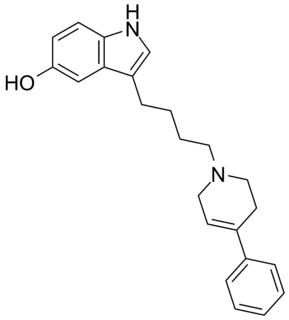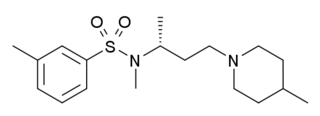
Pergolide, sold under the brand name Permax and Prascend (veterinary) among others, is an ergoline-based dopamine receptor agonist used in some countries for the treatment of Parkinson's disease. Parkinson's disease is associated with reduced dopamine activity in the substantia nigra of the brain. Pergolide acts on many of the same receptors as dopamine to increase receptor activity.

5-HT receptors, 5-hydroxytryptamine receptors, or serotonin receptors, are a group of G protein-coupled receptor and ligand-gated ion channels found in the central and peripheral nervous systems. They mediate both excitatory and inhibitory neurotransmission. The serotonin receptors are activated by the neurotransmitter serotonin, which acts as their natural ligand.

The 5-HT2A receptor is a subtype of the 5-HT2 receptor that belongs to the serotonin receptor family and is a G protein-coupled receptor (GPCR). The 5-HT2A receptor is a cell surface receptor, but has several intracellular locations. 5-HT is short for 5-hydroxy-tryptamine or serotonin. This is the main excitatory receptor subtype among the GPCRs for serotonin, although 5-HT2A may also have an inhibitory effect on certain areas such as the visual cortex and the orbitofrontal cortex. This receptor was first noted for its importance as a target of serotonergic psychedelic drugs such as LSD and psilocybin mushrooms. Later it came back to prominence because it was also found to be mediating, at least partly, the action of many antipsychotic drugs, especially the atypical ones.

A serotonin receptor agonist is an agonist of one or more serotonin receptors. They activate serotonin receptors in a manner similar to that of serotonin, a neurotransmitter and hormone and the endogenous ligand of the serotonin receptors.

8-OH-DPAT is a research chemical of the aminotetralin chemical class which was developed in the 1980s and has been widely used to study the function of the 5-HT1A receptor. It was one of the first major 5-HT1A receptor full agonists to be discovered.

5-Hydroxytryptamine receptor 2B (5-HT2B) also known as serotonin receptor 2B is a protein that in humans is encoded by the HTR2B gene. 5-HT2B is a member of the 5-HT2 receptor family that binds the neurotransmitter serotonin (5-hydroxytryptamine, 5-HT).

The 5-HT7 receptor is a member of the GPCR superfamily of cell surface receptors and is activated by the neurotransmitter serotonin (5-hydroxytryptamine, 5-HT) The 5-HT7 receptor is coupled to Gs (stimulates the production of the intracellular signaling molecule cAMP) and is expressed in a variety of human tissues, particularly in the brain, the gastrointestinal tract, and in various blood vessels. This receptor has been a drug development target for the treatment of several clinical disorders. The 5-HT7 receptor is encoded by the HTR7 gene, which in humans is transcribed into 3 different splice variants.

YM-348 is an indazole derivative drug which acts as a potent and selective 5-HT2C receptor agonist, with an EC50 of 1nM and 15x selectivity over 5-HT2A, although it only has moderate selectivity of 3x over the closely related 5-HT2B receptor. It has thermogenic and anorectic effects in animal studies, making it potentially useful for the treatment of obesity.

PNU-22394 is a drug which acts as an agonist at serotonin 5-HT2 receptors, with strongest binding affinity for 5-HT2A and 5-HT2C and slightly weaker at 5-HT2B, although it is only a full agonist at 5-HT2C, but partial agonist at 5-HT2A and 5-HT2B. It has anorectic effects in both animal studies and human trials, along with "Pro-Cognitive Properties", although it has never been developed for medical use.

ORG-37684 is a drug developed by Organon, which acts as a potent and selective agonist for the 5-HT2 receptor family, with highest affinity at 5-HT2C and lowest at 5-HT2B subtypes. It has anorectic effects in animal studies and has been researched as a potential weight loss drug for use in humans.

CGS-12066A is a drug which acts as a potent and selective agonist for the 5-HT1B receptor with lower affinity for the three 5-HT2 receptor subtypes. It is used for studying the role of the 5-HT1B receptor in various processes including perception of pain and the sleep-wake cycle.

Capeserod (INN; development code SL65.0155) is a selective 5-HT4 receptor partial agonist with Ki = 0.6 nM and IA = 40–50% (relative to serotonin). It potently enhances cognition, learning, and memory, and also possesses antidepressant effects. Capeserod was in phase II clinical trials around 2004–2006 for the treatment of memory deficits and dementia but no new information has surfaced since and it appears to have been abandoned.

Roxindole (EMD-49,980) is a dopaminergic and serotonergic drug which was originally developed by Merck KGaA for the treatment of schizophrenia. In clinical trials its antipsychotic efficacy was only modest but it was unexpectedly found to produce potent and rapid antidepressant and anxiolytic effects. As a result, roxindole was further researched for the treatment of depression instead. It has also been investigated as a therapy for Parkinson's disease and prolactinoma.

Sarizotan (EMD-128,130) is a selective 5-HT1A receptor agonist and D2 receptor antagonist, which has antipsychotic effects, and has also shown efficacy in reducing dyskinesias resulting from long-term anti-Parkinsonian treatment with levodopa.

25TFM-NBOMe is a derivative of the phenethylamine hallucinogen 2C-TFM, discovered in 2004 by Ralf Heim at the Free University of Berlin. It acts as a potent partial agonist for the 5HT2A receptor, though its relative potency is disputed, with some studies finding it to be of lower potency than 25I-NBOMe, while others show it to be of similar or higher potency, possibly because of differences in the assay used. 2C-TFM-NB2OMe can be taken to produce psychedelic effects similar to 2C-I-NB2OMe and 2C-D-NB2OMe.

SB-258719 is a drug developed by GlaxoSmithKline which acts as a selective 5-HT7 receptor partial inverse agonist, and was the first such ligand identified for 5-HT7. Its use in research has mainly been in demonstrating the potential use for 5-HT7 agonists as potential novel analgesics, due to the ability of SB-258719 to block the analgesic effects of a variety of 5-HT7 agonists across several different testing models.

5-MeO-NBpBrT is a N-substituted member of the methoxytryptamine family of compounds. Like other such compounds it acts as an antagonist for the 5-HT2A receptor, with a claimed 100x selectivity over the closely related 5-HT2C receptor. While N-benzyl substitution of psychedelic phenethylamines often results in potent 5-HT2A agonists, it had been thought that N-benzyl tryptamines show much lower efficacy and are either very weak partial agonists or antagonists at 5-HT2A, though more recent research has shown stronger agonist activity for 3-substituted benzyl derivatives. Extending the benzyl group to a substituted phenethyl can also recover agonist activity in certain cases.

SR-57227 is a potent and selective agonist at the 5HT3 receptor, with high selectivity over other serotonin receptor subtypes and good blood-brain barrier penetration.

SB-243213 is a research chemical which acts as a selective inverse agonist for the 5HT2C receptor and has anxiolytic effects. It has better than 100x selectivity for 5-HT2C over all other receptor subtypes tested, and a longer duration of action compared to older 5-HT2C antagonist ligands.

25B-NBOH is a derivative of the phenethylamine derived hallucinogen 2C-B which has been sold as a designer drug. It acts as a potent serotonin receptor agonist with similar affinity to the better-known compound 25B-NBOMe at 5-HT2A and 5-HT2C receptors with pKis values of 8.3 and 9.4, respectively.




















